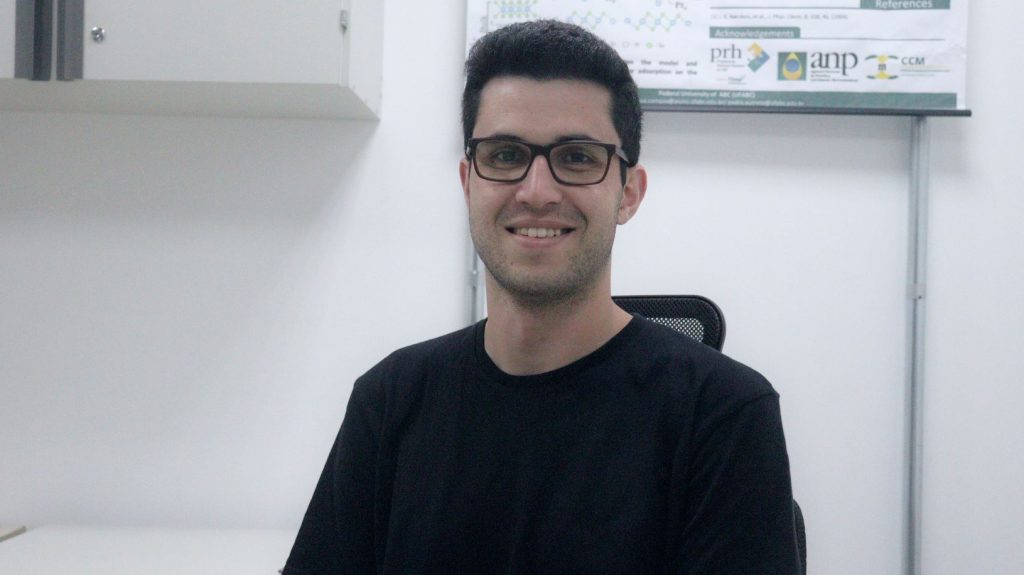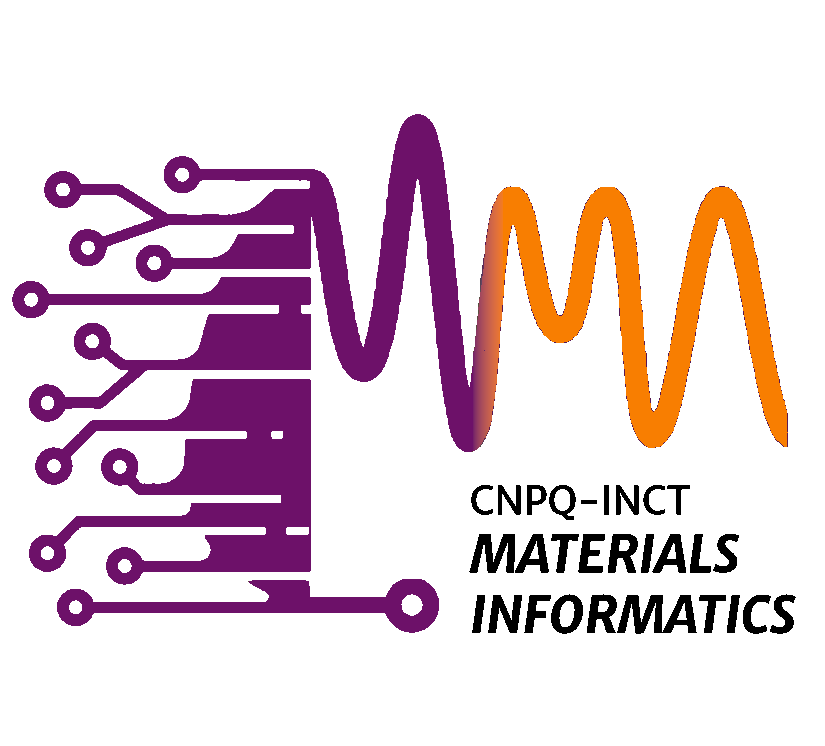
Publicações de Pedro Autreto
Mahapatra, Preeti Lata; de Oliveira, Caique Campos; Costin, Gelu; Sarkar, Suman; Autreto, Pedro A. S.; Tiwary, Chandra Sekhar Paramagnetic two-dimensional silicon-oxide from natural silicates Journal Article Em: 2D Mater., vol. 11, não 1, 2023, ISSN: 2053-1583. Resumo | Links | BibTeX | Tags: Condensed Matter Physics, General Chemistry, General Materials Science, Mechanical Engineering, Mechanics of Materials Antonin, Vanessa S.; Lucchetti, Lanna E. B.; Souza, Felipe M.; Pinheiro, Victor S.; Moura, João P. C.; Trench, Aline B.; de Almeida, James M.; Autreto, Pedro A. S.; Lanza, Marcos R. V.; Santos, Mauro C. Sodium niobate microcubes decorated with ceria nanorods for hydrogen peroxide electrogeneration: An experimental and theoretical study Journal Article Em: Journal of Alloys and Compounds, vol. 965, 2023, ISSN: 0925-8388. Resumo | Links | BibTeX | Tags: Materials Chemistry, Mechanical Engineering, Mechanics of Materials, Metals and Alloys de Oliveira, Caique Campos; Autreto, Pedro A. S. Optimized 2D nanostructures for catalysis of hydrogen evolution reactions Journal Article Em: MRS Advances, vol. 8, não 6, pp. 307–310, 2023, ISSN: 2059-8521. Links | BibTeX | Tags: Condensed Matter Physics, General Materials Science, Mechanical Engineering, Mechanics of Materials2023
@article{Mahapatra2023,
title = {Paramagnetic two-dimensional silicon-oxide from natural silicates},
author = {Preeti Lata Mahapatra and Caique Campos de Oliveira and Gelu Costin and Suman Sarkar and Pedro A. S. Autreto and Chandra Sekhar Tiwary},
url = {https://iopscience.iop.org/article/10.1088/2053-1583/ad10b9/meta},
doi = {10.1088/2053-1583/ad10b9},
issn = {2053-1583},
year = {2023},
date = {2023-12-12},
urldate = {2024-01-01},
journal = {2D Mater.},
volume = {11},
number = {1},
publisher = {IOP Publishing},
abstract = {
keywords = {Condensed Matter Physics, General Chemistry, General Materials Science, Mechanical Engineering, Mechanics of Materials},
pubstate = {published},
tppubtype = {article}
}
<jats:p>Silicon dioxide’s potential for having magnetic properties is fascinating, as combining its electronic capabilities with magnetic response seems promising for spintronics. In this work, the mechanisms that drive the change from diamagnetic behavior in pure silicates like SiO<jats:sub>2</jats:sub> to paramagnetic behavior in transition metal-doped silicates like Rhodonite silicate (CaMn<jats:sub>3</jats:sub>Mn(Si<jats:sub>5</jats:sub>O<jats:sub>15</jats:sub>)) are explored. This naturally occurring Rhodonite (R)-silicate was thinned down while retaining its magnetic properties by liquid-phase scalable exfoliation. Exfoliating R-silicate into the two-dimensional (2D) structure by LPE increases magnetic coercivity, and the internal resistance to demagnetization (ΔHc) up to ∼23.95 Oe compared to 7.08 Oe for its bulk phase. DFT spin-polarized calculations corroborate those findings and explain that the origin of the magnetic moment comes mainly from the Mn in the doped 2D silicate due to the asymmetrical components of the Mn d and Si p states in the valence band. This result is further illustrated by the spin component differential charge densities showing that Mn and Si atoms display a residual up spin charge. Rhodonite’s unusual magnetic behavior has considerable potential for spintronics, data storage, and sensing technologies. Understanding the complex relationships between the structural, magnetic, and electronic properties of silicates is essential for developing new materials and composites as well as for driving future research.</jats:p>@article{Antonin2023,
title = {Sodium niobate microcubes decorated with ceria nanorods for hydrogen peroxide electrogeneration: An experimental and theoretical study},
author = {Vanessa S. Antonin and Lanna E.B. Lucchetti and Felipe M. Souza and Victor S. Pinheiro and João P.C. Moura and Aline B. Trench and James M. de Almeida and Pedro A. S. Autreto and Marcos R.V. Lanza and Mauro C. Santos},
url = {https://www.sciencedirect.com/science/article/abs/pii/S092583882302666X},
doi = {10.1016/j.jallcom.2023.171363},
issn = {0925-8388},
year = {2023},
date = {2023-07-21},
urldate = {2023-11-00},
journal = {Journal of Alloys and Compounds},
volume = {965},
publisher = {Elsevier BV},
abstract = {The present work investigates the catalytic activity of NaNbO3 microcubes decorated with CeO2 nanorods on carbon (1 %, 3 %, 5 %, and 10 % w/w) for H2O2 electrogeneration. The crystalline phases and the morphology of the materials were identified with scanning electron microscopy, transmission electron microscopy, X‐ray diffraction and X-ray Photoelectronic spectroscopy. Contact angle measurements were performed to characterize the hydrophilicity of each material. The H2O2 electrogeneration was assessed by oxygen reduction reaction using the rotating ring-disk electrode technique. Electrochemical characterization results shown an enhancement on the H2O2 electrogeneration by NaNbO3 @CeO2/C-based materials compared to what was obtained with pure Vulcan XC72. The 1 % NaNbO3 @CeO2/C electrocatalyst presented the lower starting potential for the ORR and a 2.3 electron transfer, favoring the 2-electron mechanism and providing a higher H2O2 electrogeneration rate. Also, the enhancement of oxygen-containing functional groups showed the potential to comprehensively tune properties and optimize active sites and, consequently, increases the H2O2 electrogeneration. Density functional theory calculations indicated that NaNbO3 and CeO2 surfaces have a similar low theoretical overpotential for this reaction and that CeO2 improves the catalyst facilitating the electron transfer. These results indicate that NaNbO3 @CeO2/C-based electrocatalysts are promising materials for in situ H2O2 electrogeneration.},
keywords = {Materials Chemistry, Mechanical Engineering, Mechanics of Materials, Metals and Alloys},
pubstate = {published},
tppubtype = {article}
}
@article{Oliveira2023b,
title = {Optimized 2D nanostructures for catalysis of hydrogen evolution reactions},
author = {Caique Campos de Oliveira and Pedro A. S. Autreto},
doi = {10.1557/s43580-023-00549-7},
issn = {2059-8521},
year = {2023},
date = {2023-06-00},
urldate = {2023-06-00},
journal = {MRS Advances},
volume = {8},
number = {6},
pages = {307--310},
publisher = {Springer Science and Business Media LLC},
keywords = {Condensed Matter Physics, General Materials Science, Mechanical Engineering, Mechanics of Materials},
pubstate = {published},
tppubtype = {article}
}
Orientados e Supervisionados por Pedro Autreto

Bruno Ipaves
Vínculo: Pós-Doutorado
Instituição: Universidade Federal do ABC (UFABC)
Laboratório: GEEDAI
Projeto: Armazenamento e atividade catalítica de reação de evolução de hidrogênio em nanoestruturas bidimensionais porosas de carbono dopadas: obtenção de descritores de estrutura eletrônica e aprendizado de máquina para reconhecimento de padrões (Bolsista INCT-MI)

Tiago Duarte
Vínculo: Bolsista
Instituição: Universidade Federal do ABC (UFABC)
Laboratório: GEEDAI
Projeto: Disseminação do conhecimento científico produzido pela equipe de pesquisadores através de conteúdo digital, material gráfico, produção de tutoriais técnicos e atividades que visam o fortalecimento do nome do INCT – Materials Informatics. (Bolsista INCT-MI)

Juan Gomez
Vínculo: Doutorado
Instituição: Universidade Federal do ABC (UFABC)
Laboratório: GEEDAI
Projeto: Em breve

Mara Cardoso Machado
Vínculo: Mestrado
Instituição: Universidade Federal do ABC (UFABC)
Laboratório: GEEDAI
Projeto: Peapods Híbridos: análise das propriedades mecânicas.

Caique Oliveira
Vínculo: Mestrado
Instituição: Universidade Federal do ABC (UFABC)
Laboratório: GEEDAI
Projeto: Em breve.

Thales Machado
Vínculo: Iniciação Científica
Instituição: Universidade Federal do ABC (UFABC)
Laboratório: GEEDAI
Projeto: Em breve.

Matheus Medina
Vínculo: Iniciação Científica
Instituição: Universidade Federal do ABC (UFABC)
Laboratório: GEEDAI
Projeto: Efeitos da decoração e dopagem no armazenamento de hidrogênio do TPDH-grafeno.


